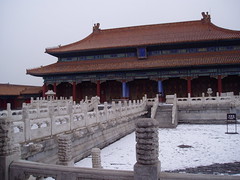White on Rice
Figured I'd write a little bit on real Chinese food. It is quite different from what one might find in the West, especially compared to what is traditionally served up here in the north. Also becaue I've lost 14 pounds or so, though I've still been eating quite well.
To begin, most of what the average Occidental considers to be Chinese food originates from Sichuan province (Szehuan). For those who didn't take Map of the Modern World (Eric Rahn and Jenny Cosco, you're being tested here) Sichuan province is towards southwest of Tibet, bordering on Tibet. I'm in Heilongjiang province, as far north and east as you can get. Food from the Sichuan school is traditionally spicier, obviously due to the warmer climate. Spicy foods, which induce a sweat, help people stay cool in the heat and humidity. Think about all the more equitorial cuisines (Thai, Mexican, Indian, etc.), thats why they are all similar in that regard.
Up here in the north it's all about solid, sturdy food that keeps you warm. Lots of starches, lots of cabbage, as cabbage is impervious to the frost and can not only transport easily but keep though the winter. But, as China has now modernized, you can find dishes from all regions almost anywhere.
Chinese food gets split into three categories: meat, vegetables, and food. Yes, I repeat: meat, vegetable, and food. I've gotten in many an argument over this. Meats and vegetable are not considered "food." All three have different characters. "Food" is what fills you up, "food" is the staple of the Chinese diet: rice, dumplings, pancakes, anything based off any sort of rice, grain, millet, or so forth. Meat and vegetables are to be balanced, just like the yin and yang. In a way, almost everything from the Forbidden Palace to meals to lesson plans are designed around the yin and yang. A meal without something from each camp is considered unbalanced. Meats stand as the male element of the feast and are usually spicy if not full of some other flavor. The vegetable, as the female element, is traditionally cooling in nature.
Here are some of my favorites:
JIAOZI: Hands down my favorite dish, a "food" of true utility. Jiaozi, or dumplings, we're popularized by the necessity of feasting with meat on festival days. A jiaozi consists of a small ball of ground meat and vegetables in the middle of a think noodle-like wrapping. As most Chinese were poor, this is the best way of making a little meat go a long way. Great with some ground red chili paste, soy sauce, and vinegar. Sometimes fried.
BAOZI: Similar to jiaozi, but the wrapping is more bread-like than noodle-like. Both Baozi and jiaozi can be bought right off the street. I picked up 6 baozi today for the equivalent of 18 cents and I couldnt finish them.
DISANXIAN: Literally "Three Treasures," disanxian is a vegetable dish of eggplant, potato, and green pepper stirfried a bit. Most foods are stirfried, usually heavily oiled.
CAOMAOBING: A wispy little pancake that you tear apart as you lather meats all over it. Quite good. Different from the usuall BING, or pancake, which you roll things up in. Everything is better in a pancake.
CHUAR: Mongolian BBQ. As I gave a 2 hour lecture on American BBQ, I now know the textbook difference. (First off, grilling burgers is not BBQ.) At a chuar restaraunt most of your food is served on wooden spires, like shish kebobs, and grilled oved a charcoal flame and seasoned with various hot spices. My favorites are the lamb, pepper, and potato sticks, and I tend to stay away from the silkworms (youre not supposed to eat the heart of the silkworm, and I cant figure out how to seperate it properly). The Chinese believe chuar, though delicious, is poisonous, and if you dont eat a healthy portion of garlic after you will die.
HOTPOT: Just like it sounds, very similar to fondue. You dip anything in that you want. I'm not a huge fan.
CHINESE BURRITO: I still havent figured out what this is called, but there are restaraunts that wrap anything in a huge pancake, like a burrito. I saw a guy with a beef, onion, and chocolate chip burrito at a bar two weeks ago. He didnt have many people sitting with him.
All the food in China is served family style, that is, to share. Eating alone is considered weird, really weird. Many times have I been dining alone and somebody will come in, see me by my lonesome, and sit with me to share food and provide company. Fine by me, as they are usually so amused by the fact I can speak with them that they pay for dinner and often get me drunk. Or try. I've left more than one Harbiner woozy with pijiou (beer) as the legendary McGonigle tolerance lays waste to a nation full of Rich Storys.


0 Comments:
Post a Comment
<< Home